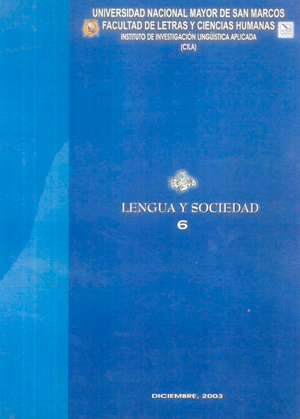Quechuisms in the Spanish spoken in Lima
DOI:
https://doi.org/10.15381/lengsoc.v1i6.26478Keywords:
QuechuismsAbstract
Quechua is a structurally different language and, apparently, does not share typological properties with the Spanish language1. This article offers observations on some linguistic processes that have been occurring as a consequence of the long coexistence of these systems. Specifically, these are cases of Quechua influence in the lexical repertoire of Spanish. In some cases such influence is evident structurally and semantically; In others, some special attention and even some analysis is required to reach the conclusion of the existence of said relationship. Even though it can be said intuitively that the influence is greater in the Spanish➔ Quechua2 direction, the latter has not been a totally passive recipient of the Spanish influence, since there are examples that show the active role of the Quechua system influencing the Spanish system.
The Quechua influence on the Spanish language occurs in aspects such as phonetics, syntax, semantics and, much more evident, in the lexical repertoire. This process began very early, perhaps, from the first moment in which contact occurred between speakers of both languages.
In this article, the existence and official recognition of the so-called Quechua loans to the lexical repertoire of Spanish is taken for granted. This is a considerable number of words3 recognized today by the Spanish Academy. Our central interest is directed to the "words" that do not appear in the Dictionary or that, having been recorded therein, are not clearly glossed, however, they color everyday Hispanic discourse. We are referring to terms that users take as natives of the Spanish language, when in reality they are lexical elements of Quechua origin "camouflaged" in Spanish structures.
Terms of Quechua origin that are not officially recognized are included in the so-called youth "jargons" even though, during communication, they are on the "lips", not only of the youth sector, but also forming part of the lexical repertoire of speakers of different ages. and sociocultural levels of the city of Lima.
Downloads
Published
Issue
Section
License
Copyright (c) 2003 Rómulo Quintanilla Anglas

This work is licensed under a Creative Commons Attribution 4.0 International License.
AUTHORS RETAIN THEIR RIGHTS
a. Authors retain their trade mark rights and patent, and also on any process or procedure described in the article.
b. Authors can submit to the journal Lengua y Sociedad, papers disseminated as pre-print in repositories. This should be made known in the cover letter.
c. Authors retain their right to share, copy, distribute, perform and publicly communicate their article (eg, to place their article in an institutional repository or publish it in a book), with an acknowledgment of its initial publication in the journal Lengua y Sociedad.
d. Authors retain theirs right to make a subsequent publication of their work, to use the article or any part thereof (eg a compilation of his papers, lecture notes, thesis, or a book), always indicating its initial publication in the journal Lengua y Sociedad (the originator of the work, journal, volume, number and date).



























